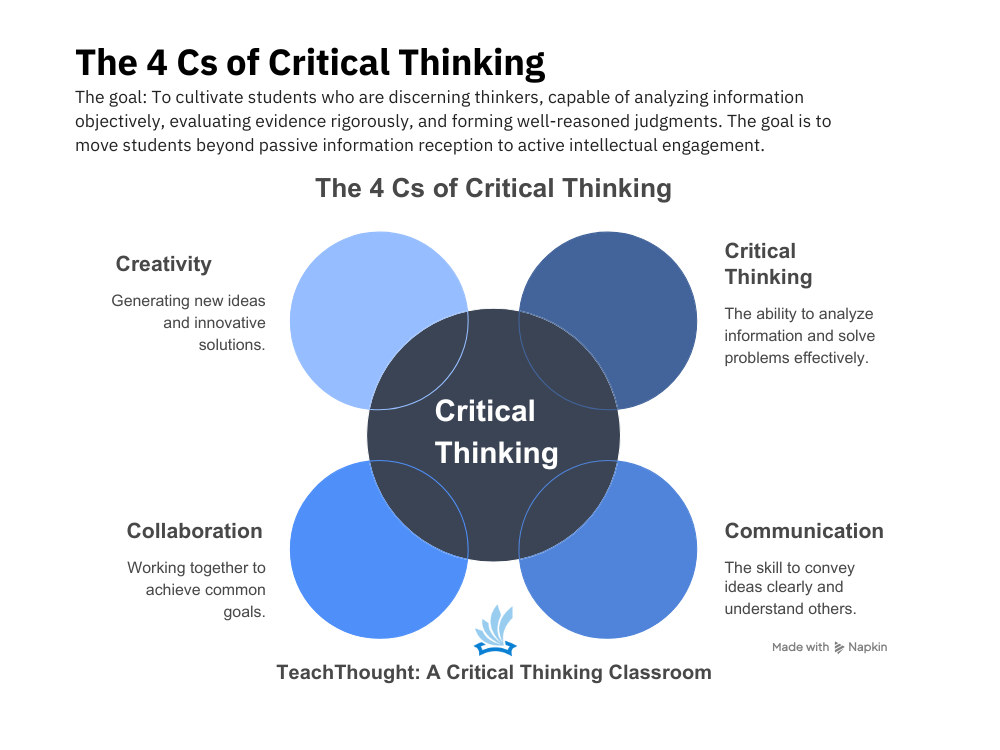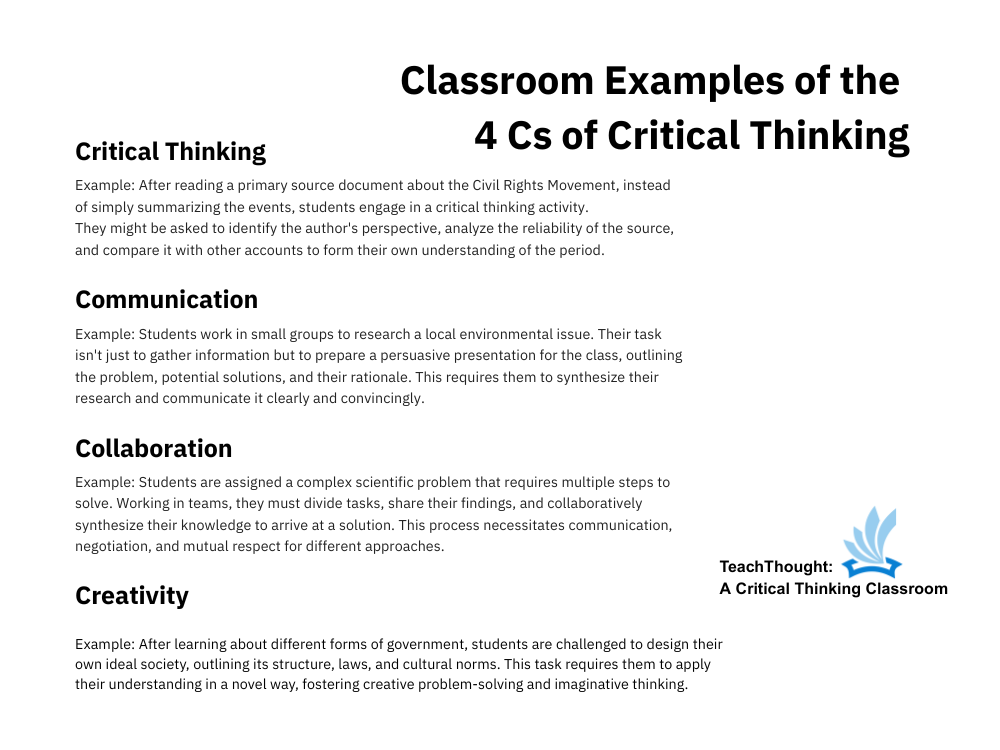
The Foundational 4 Cs of Critical Thinking in K-12 Education
by TeachThought Staff
What Are The 4 Cs of Critical Thinking?
Critical thinking, as a concept and practice, can be framed in various ways. It can be seen, for example, through its function as a social construct, its relationship with literacy, its necessity in political elections, and so on.
One of the more popular ways it is seen is in the 4 Cs. Critical Thinking, Communication. Collaboration, and Creativity.
Critical Thinking: The suspension of judgment while identifying biases and underlying assumptions in order to draw accurate conclusions
Key traits: evidence, support, analysis, humility, clarity, flexibility
Communication
To communicate is to clearly and purposefully express ideas, questions, and reasoning in ways that can be understood, evaluated, and constructively responded to. It involves not just speaking or writing, but translating thought into form, recognizing the audience, and using evidence and logic to support clarity and precision.
Key traits: clarity, coherence, logical structure, responsiveness to feedback.
Collaboration
Collaboration is the intentional process of engaging with others to explore ideas, challenge thinking, and co-construct meaning or solutions. It requires openness to diverse perspectives, evaluating arguments respectfully, and building consensus based on reason and evidence, not just agreement.
Key traits: active listening, shared reasoning, respectful disagreement, joint problem-solving.
Creativity
Creativity is the ability to generate original, flexible, and effective ideas by connecting concepts in novel ways. It is not just about expression, but about innovative problem-solving—challenging assumptions, exploring alternatives, and constructing new frameworks for understanding.
Key traits: divergent thinking, intellectual risk-taking, synthesis, originality with purpose.
See also The Definition Of A Socratic Seminar

The Definition Of The 4 Cs
1. Critical Thinking
The Idea: To cultivate students who are discerning thinkers, capable of analyzing information objectively, evaluating evidence rigorously, and forming well-reasoned judgments. The hope is to move students beyond passive information reception to active intellectual engagement.
Short Definition: Analyzing information and identifying biases and underlying assumptions to draw accurate conclusions. We know that “critical thinking involves the ‘suspension of judgment while analyzing information to arrive at well-supported understandings.” (See The Definition Of Critical Thinking.)
Benefit: Critical thinking helps students to become independent learners and problem-solvers. They develop the ability to question, investigate, and make informed decisions, skills essential for academic success and navigating life beyond the classroom.
See 10 Benefits Of Inquiry-Based Learning
Classroom Example
After reading a primary source document about the Civil Rights Movement, instead of simply summarizing the events, students engage in a critical thinking activity.
They might be asked to identify the author’s perspective, analyze the reliability of the source, and compare it with other accounts to form their own nuanced understanding of the period.
2. Communication
The Idea: To develop students who can articulate their thoughts and ideas effectively, both orally and in writing, with clarity, coherence, and purpose. We aim for students to be able to convey complex information and engage in meaningful dialogue with diverse audiences.
Short Definition: Expressing ideas, thoughts, and information clearly and effectively through various mediums (oral, written, visual, digital).
Benefit: Strong communication skills enable students to share their understanding, collaborate effectively, and participate actively in their learning community. The ability to articulate their reasoning is intrinsically linked to critical thinking, allowing them to explain why they have reached a particular conclusion.
Classroom Example
Students work in small groups to research a local environmental issue. Their task isn’t just to gather information but to prepare a persuasive presentation for the class, outlining the problem, potential solutions, and their rationale. This requires them to synthesize their research and communicate it clearly and convincingly.
3. Collaboration
The Idea: To grow students who can work effectively and respectfully with others to achieve common goals. We aim to develop their ability to share ideas, negotiate, compromise, and contribute their unique strengths within a team.
Short Definition: Working cooperatively with others, sharing ideas, and contributing to a collective effort to achieve a shared objective.
Benefit: Collaboration enhances learning by exposing students to diverse perspectives and fostering shared understanding. It mirrors real-world scenarios where problem-solving often requires teamwork and the ability to leverage different skills and viewpoints. Research highlights the link between collaborative learning and improved critical thinking skills (Johnson & Johnson, 2009).
Classroom Example
Students are assigned a complex scientific problem that requires multiple steps to solve. Working in teams, they must divide tasks, share their findings, and collaboratively synthesize their knowledge to arrive at a solution. This process necessitates communication, negotiation, and mutual respect for different approaches.
4. Creativity
The Idea: To cultivate students who are innovative thinkers, capable of generating novel ideas, exploring possibilities, and approaching challenges with imagination and originality. We aim to nurture their capacity for ‘thinking outside the box’ and finding unique solutions.
Short Definition: Generating new ideas, making novel connections, and approaching tasks with imagination and originality.
Benefit: Creativity allows students to approach problems from fresh angles and develop unique solutions. It fosters innovation and adaptability, crucial skills in a rapidly changing world. Engaging in creative tasks can also deepen understanding and make learning more memorable.
Classroom Example
After learning about different forms of government, students are challenged to design their own ideal society, outlining its structure, laws, and cultural norms. This task requires them to apply their understanding in a novel way, fostering creative problem-solving and imaginative thinking.
Works Cited
Johnson, D. W., & Johnson, R. T. (2009). An elaboration of psychological interdependence. Psychological Bulletin, 135(2), 282–318.
Gay, G. (2018). Culturally responsive teaching: Theory, research, and practice (3rd ed.). Teachers College Press.